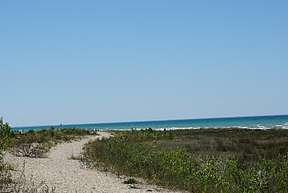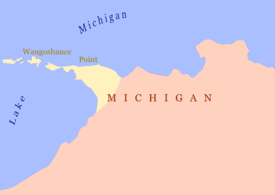Wilderness State Park
| Wilderness State Park | |
|---|---|
|
IUCN category V (protected landscape/seascape) | |
 Wilderness State Park, June 2014 | |
 Location in Michigan | |
| Location | Bliss Township, Emmet County, Michigan, United States |
| Nearest town | Mackinaw City, Michigan |
| Coordinates | 45°44′03″N 84°54′10″W / 45.73417°N 84.90278°WCoordinates: 45°44′03″N 84°54′10″W / 45.73417°N 84.90278°W [1] |
| Area | 10,512 acres (4,254 ha) |
| Elevation | 607 feet (185 m) [1] |
| Designation | Michigan State Park |
| Established |
1922 (game reserve); 1927 (state park) |
| Administrator | Michigan Department of Natural Resources |
| Website | Wilderness State Park |
Wilderness State Park is a public recreation area bordering Lake Michigan, five miles southwest of Mackinaw City in Emmet County in Northern Michigan. The state park's 10,512 acres (4,254 ha) include 26 miles (42 km) of shoreline, diverse forested dune and swale complexes, wetlands, camping areas, and many miles of hiking trails.[2] The state park is operated by the Michigan Department of Natural Resources, which has, as of 2006, approved a proposal that 4,492 acres (1,818 ha) be officially dedicated as a wilderness area.[3] Wilderness State Park was designated a Michigan "dark sky preserve" in 2012.[4]
Description

One of the most prominent physical features of the park is Waugoshance Point, which juts westward into northern Lake Michigan. Beyond the tip of the point, Temperance Island and Waugoshance Island are also parts of the state park. Four Lake Michigan lighthouses sit near the park's western boundary. Stations at Grays Reef, Skillagalee Island, Waugoshance, and White Shoal warn shipping away from the dangerous reefs and shoals of Waugoshance Point.
History
The state began acquiring the park's lands in 1896 through purchase and tax reversion proceedings. After the reversion of additional acreage for tax nonpayment in the early years of the twentieth century, the site became the Emmet State Game Refuge in 1922, with the land set aside for the breeding of game birds and other animals. When the game reserve was placed under the administration of the Parks Division in 1927, it officially became Wilderness State Park.[5]
The Civilian Conservation Corps was active in the park for six years during the 1930s. The corps' workers built various structures, eight miles of trails, a public campground, and four-acre Goose Pond.[5]
Wildlife
The park supports populations of many animals that are part of the traditional image of the northern Great Lakes ecosystem, including American black bear, beaver, bobcats, mink, muskrats, and otter.[2] The park's cobble beach areas provide an excellent habitat for the federally endangered piping plover. As of 2002, approximately one-third of Michigan's nesting pairs of piping plovers were found in Wilderness State Park.[3] One of the first sightings of wolves in the Lower Peninsula was reported along the park's shoreline by a Coast Guard pilot in 1997.[6] In 2015, MDNR officials confirmed the presence of wolves in the Lower Peninsula.[7]
Activities and amenities
The state park offers swimming, picnicking, boat launch, fishing, a 250-site campground and cabins. The state park contains 16 miles (26 km) of trails for hiking, mountain biking, cross-country skiing and snowmobiling, that include a 10-mile-long (16 km) section of the North Country Trail.
References
- 1 2 "Wilderness State Park". Geographic Names Information System. United States Geological Survey.
- 1 2 "Wilderness State Park". Michigan Department of Natural Resources. Retrieved June 19, 2018.
- 1 2 "Wilderness State Park". Michigan Department of Natural Resources. Retrieved July 17, 2018.
- ↑ "Michigan's dark sky sites take the spotlight". Detroit News. April 8, 2016. Retrieved June 19, 2018.
- 1 2 "Wilderness State Park General Management Plan" (PDF). Michigan Department of Natural Resources. p. A-7. Retrieved April 5, 2016.
- ↑ DuFresne, Jim (2005). The Complete Guide to Michigan Sand Dunes. Ann Arbor, Michigan: University of Michigan Press. p. 150. ISBN 047203118X.
- ↑ Ellison, Garret (September 17, 2015). "DNA test confirms gray wolf presence in Michigan's Lower Peninsula". MLive. Retrieved July 17, 2018.
External links
| Wikimedia Commons has media related to Wilderness State Park. |
- Wilderness State Park Michigan Department of Natural Resources
- Wilderness State Park Map Michigan Department of Natural Resources
- Wilderness State Park Protected Planet